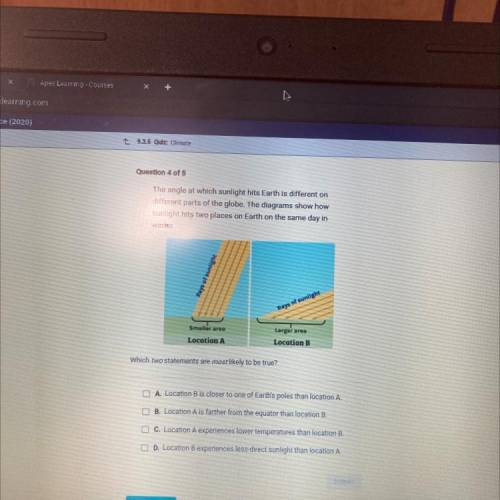
The angle at which sunlight hits Earth is different on
different parts of the globe. The diagrams show how
sunlight hits two places on Earth on the same day in
winter
Rays of sunlight
Rays of sunlight
Smaller area
Larger area
Location B
Location A
Which two statements are most likely to be true?
A. Location B is closer to one of Earth's poles than location A.
B. Location A is farther from the equator than location B.
C. Location A experiences lower temperatures than location B.
DD. Location B experiences less-direct sunlight than location A.


Answers: 1


Other questions on the subject: Physics

Physics, 22.06.2019 04:00, binodkharal2048
Which configuration would produce an electric current? a) rotate a coil of copper wire between two magnets. b) connect a wire between a copper and zinc strip sitting in a beaker of water. c) connect a wire to the (+) positive end of a battery and the other end to a light bulb. d) connect a wire to the negative end of a battery and the other end to a light bulb.
Answers: 2

Physics, 22.06.2019 06:40, PerfectMagZ
Alinearly polarized electromagnetic wave has an average intensity of 196 w/m^2. this wave is directed towards two ideal polarizers (in real polarizers, transmission is also effected by reflection and absorption). polarizer a is oriented with its transmission axis at an angle of θ_1=20.8∘ with the incident electric field. polarizer b has its axis at an angle of θ_2=63.0∘ with the incident electric field. what is the average intensity of the wave after it passes through polarizer a? what is the average intensity of the wave after it passes through polarizer b? suppose that the two polarizers a and b are interchanged. what would the average intensity be after passing through both polarizers?
Answers: 2


Physics, 22.06.2019 22:00, saucyyyyniahhhhh
Four friends, a, b, c, and d are standing varying distances away from a speaker which is producing sound waves.
Answers: 2
You know the right answer?
The angle at which sunlight hits Earth is different on
different parts of the globe. The diagrams...
Questions in other subjects:



Mathematics, 18.03.2021 01:50

Mathematics, 18.03.2021 01:50






History, 18.03.2021 01:50



